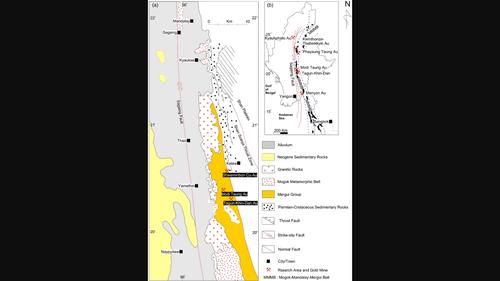Geological, mineralogical and ore fluid characteristics of the Tagun‐Khin‐Dan gold mineralization in Mogok‐Mandalay‐Mergui Belt, Central Myanmar
IF 0.8
4区 地球科学
Q3 GEOLOGY
引用次数: 0
Abstract
The Tagun‐Khin‐Dan gold deposit in the Mogok‐Mandalay‐Mergui Belt, Central Myanmar, is characterized by an array of quartz‐veins hosted in mudstone of the Kogwe Formation of the Carboniferous Mergui Group. Two major deformational stages were recorded in the area; (1) N‐S shortening and (2) uplifting and emplacement of various dykes and quartz veinlets. The N‐S shortening within the area lead the development of km‐scale faults, determined largely by the presence of a zone of major WNW‐ESE trending dextral strike‐slip faulting. Quartz veins in the deposit include: (1) type‐A quartz veins, parallel to the dextral NW‐SE trending major fault; and (2) type‐B quartz veins which occur as isolated parallel veins. Gold in the type‐A quartz vein is present as native gold and electrum locked within pyrite and associated with pyrite and galena and in the type‐B quartz veins as electrum associated with sulfide minerals such as pyrite, chalcopyrite, galena and sphalerite. The mineralization stages can be classified into the type‐A quartz vein stage and the type‐B quartz vein stage. Two type of fluid inclusions; liquid‐rich aqueous inclusions (L‐type) and vapor‐rich aqueous inclusions (V‐type) are identified in the type‐A quartz veins. The homogenization temperature of L‐type fluid inclusions of the type‐A quartz veins ranges from 203 to 321°C and salinity of the fluid inclusions varies from 0.4 to 1.6 wt% NaCl equiv. The homogenization temperature of V‐type fluid inclusions of type‐A quartz veins ranges from 290 to 340°C with a salinity ranging from 0.4 to 1.9 wt% NaCl equivalent. In the type‐B quartz veins, only liquid‐rich aqueous inclusions (L‐type) are identified. The type‐B quartz veins yielded low homogenization temperatures from 160 to 220°C, with low salinities from 0.2 to 1.9 wt% NaCl equiv. compared with those of the type‐A veins. The depth range of ore formation is estimated to be a shallow depth of less than 0.2 km based on fluid inclusion microthermometry. Fluid boiling is evident during the type‐A quartz vein stage, and fluid cooling and mixing in the later type‐B quartz vein stage. Precipitation of pyrite in the ore zone occurred as four recognized types: arsenic‐rich pyrite‐1, 2, 3 in the type‐A quartz veins and pyrite‐4 in the type‐B quartz veins. A positive relation between Au and As contents of pyrites suggests that the gold is present together with arsenic in the structure of pyrites of the type‐A quartz veins as solid solution in addition to as nanoparticle inclusions. The high Co and Ni contents of pyrites of both the type‐A and the type‐B quartz veins, with no evidence of CO2 in the system indicate that the ore‐forming fluids were epizonal magmatic‐hydrothermal fluids rather than metamorphic fluid. The hydrothermal fluids of the Tagun‐Khin‐Dan deposit were driven by faulting to form the mudstone‐hosted epithermal gold mineralization and related to continuing northwards movement of the Indian Plate that initiated the displacement on the strike‐slip Sagaing Fault.

缅甸中部摩谷—曼德勒—梅尔桂带塔贡—钦—丹金矿成矿地质、矿物学及矿石流体特征
在缅甸中部Mogok - Mandalay - Mergui带的Tagun - Khin - Dan金矿床,其特征是在石炭系Mergui群Kogwe组泥岩中赋存一系列石英脉。该地区记录了两个主要的变形阶段;(1)北向缩短;(2)各种岩脉和石英脉的隆起和就位。南北向缩短导致区域内km级断层的发育,这主要是由一个主要的WNW - ESE向右走滑断层带的存在决定的。矿床中的石英脉包括:(1)A型石英脉,平行于右旋NW - SE走向的大断裂;(2) B型石英脉,为孤立的平行脉。A型石英脉中的金以天然金和银锭的形式存在于黄铁矿中,并与黄铁矿和方铅矿伴生;B型石英脉中的金以银锭的形式存在于硫化物矿物中,如黄铁矿、黄铜矿、方铅矿和闪锌矿。成矿阶段可分为A型石英脉期和B型石英脉期。两种类型的流体包裹体;在A型石英脉中发现了富液包裹体(L型)和富气包裹体(V型)。A型石英脉的L型流体包裹体均一温度为203 ~ 321℃,盐度为0.4 ~ 1.6 wt% NaCl当量,A型石英脉的V型流体包裹体均一温度为290 ~ 340℃,盐度为0.4 ~ 1.9 wt% NaCl当量。在B型石英脉中,只鉴定出富含液体的水包裹体(L型)。与A型石英脉相比,B型石英脉的均一温度为160 ~ 220℃,盐度为0.2 ~ 1.9 wt% NaCl当量。根据流体包裹体显微测温,估计成矿深度范围为小于0.2 km的浅层。A型石英脉阶段流体沸腾明显,B型石英脉阶段流体冷却混合明显。黄铁矿在矿带中的沉淀可分为四种类型:A型石英脉中的富砷黄铁矿- 1、2、3和B型石英脉中的富砷黄铁矿- 4。黄铁矿中Au和As的正相关关系表明,在A型石英脉的黄铁矿结构中,金和砷除了以纳米包裹体的形式存在外,还以固溶体的形式存在。A型和B型石英脉黄铁矿Co和Ni含量均较高,且系统中无CO2存在,说明成矿流体为层状岩浆热液,而非变质流体。塔贡-钦-丹矿床的热液流体在断裂作用下形成泥岩型浅成热液金矿化,并与印度板块的持续北移有关,该运动引发了实皆断层的走滑位移。
本文章由计算机程序翻译,如有差异,请以英文原文为准。
求助全文
约1分钟内获得全文
求助全文
来源期刊

Resource Geology
地学-地质学
CiteScore
2.30
自引率
14.30%
发文量
18
审稿时长
12 months
期刊介绍:
Resource Geology is an international journal focusing on economic geology, geochemistry and environmental geology. Its purpose is to contribute to the promotion of earth sciences related to metallic and non-metallic mineral deposits mainly in Asia, Oceania and the Circum-Pacific region, although other parts of the world are also considered.
Launched in 1998 by the Society for Resource Geology, the journal is published quarterly in English, making it more accessible to the international geological community. The journal publishes high quality papers of interest to those engaged in research and exploration of mineral deposits.
 求助内容:
求助内容: 应助结果提醒方式:
应助结果提醒方式:


